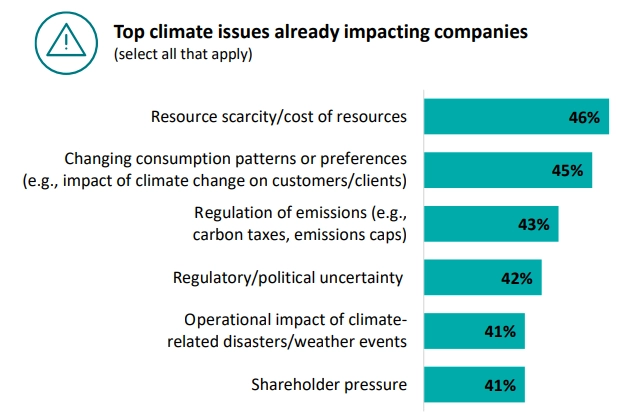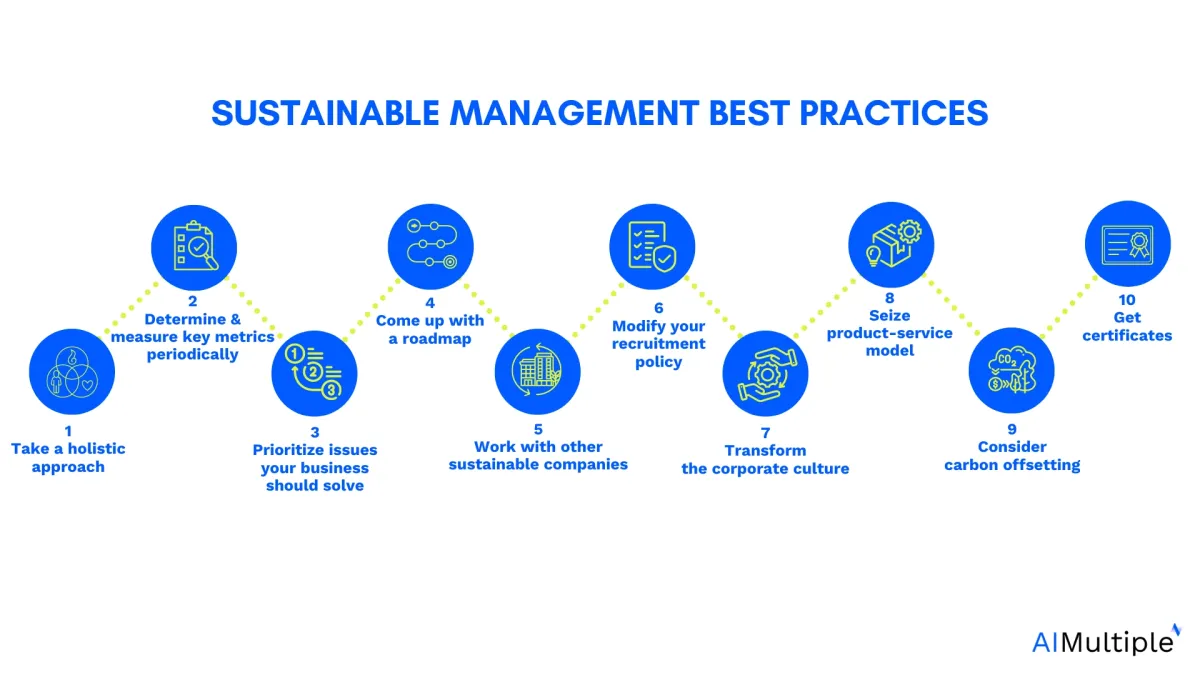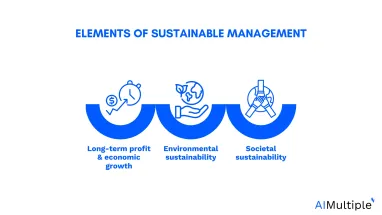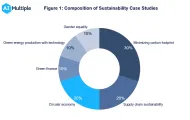In 2023, people consumed 1.8 times more resources than Earth generates annually because our economic outlook is based on production, use, and disposal.1 According to the Edelman Trust Barometer 2024, around half of individuals think businesses in the U.S. are not doing enough to address innovations such as green energy.2
All of these trends and my academic researches highlighted the need for a more holistic management perspective and execution than the current management approach.
Explore the sustainable management concept, importance of it and top 10 best practices in depth:
What is sustainable management?
Sustainable management takes into account the fact that irresponsible economic actions make it difficult to preserve the division of labor and a livable planet in the long run. It is concerned with people’s long-term well-being, including the business itself.
Researches on corporate sustainability management suggest that many corporations’ profits are based on a lack of understanding of environmental and societal challenges.3 which is not sustainable since
- We live on a planet with finite resources.
- Consumers and investors consider companies’ ESG practices when deciding whether to buy their products or invest in them.
- The number of environmental-related lawsuits is on the rise.4
Sustainable management researches aim to find answers on how we may meet our needs without harming current and future generations’ natural and social resources. Three elements constitute sustainable management:
Long-term profit and economic growth
From an economic standpoint, sustainability management emphasizes the importance of considering long-term growth. Because of the agency issues,5 many businesses focus on short-term gains,6 but sustainable practices encourage organizations to consider future consequences.
A company’s sustainability management plan is integral to managing long-term growth by reducing costs,7 increasing efficiency, and improving profitability over time. This approach benefits both businesses and stakeholders by promoting the sustainable development of financial resources. As most companies have realized, future profitability often depends on addressing sustainability efforts today.
Environmental sustainability
The concept of environmental sustainability emphasizes the need to manage natural resources responsibly, considering that Earth’s resources and waste capacity are finite. To avoid depleting these resources and to mitigate the negative impacts of business operations, sustainability managers and organizations must develop and implement sustainability strategies that address their environmental footprint.
This includes
- Adopting circular economy practices,
- Minimizing corporate carbon footprint and
- Ensuring supply chain sustainability to minimize its environmental burden.
Companies are also tasked with complying with local environmental regulations and focusing on reducing air pollution, including GHG emissions, and energy consumption. By incorporating environmental science and sustainable practices into their sustainability management plans, businesses contribute to environmental protection and address the challenges of climate change and resource conservation.
Societal sustainability management
Sustainability management also includes societal sustainability, which is vital for creating a productive and harmonious workplace.8
Companies need to foster a sense of inclusivity and fairness to promote long-term employee satisfaction. Incorporating social responsibility initiatives, such as addressing the gender pay gap, ensures that companies not only meet the demands of sustainability strategies but also align with broader societal expectations.
Business practices that focus on social responsibility create an environment of fairness, reducing conflict within the company and supporting long-term economic growth. This improves employee well-being, strengthens organizational harmony, and enhances the company’s reputation as well as customer satisfaction.
Businesses’ sustainability management plans often include tracking societal metrics, and sustainability managers are tasked with data collection to monitor progress on these metrics.
Importance of sustainable management
Corporate life aspects
According to Deloitte, almost all businesses are impacted by climate change and environmental issues, either directly or indirectly,9 as a result of:
- Resource scarcity
- Changing consumption patterns or preferences
- Regulation of emissions
- Regulatory/political uncertainty
- Operational impact of climate-related disasters
- Shareholder pressure
Figure 1: Top 5 climate change-related issues that affect businesses

Source: Deloitte10
According to the report, more than 70% of executives feel concerned about climate change, which threatens more than their businesses.
Society aspects
Traditional gender biases affect investor and corporate decisions from hiring to investment.11 From a societal standpoint, nearly half of women consider that a company’s stance on gender issues influences their decision.12
Unfortunately, gender inequality is only one of the social challenges. Almost 60% of the individuals worry about experiencing prejudice or racism, which shows the effect of discrimination in society.13
When we consider job environments that are exclusionary based on race, gender, lifestyle, and other factors, it means that organizations that are less concerned about social problems are missing out on a significant portion of the population as potential employees.
Top 10 sustainable management best practices

1. Take a holistic approach
Systems thinking helps companies to become more sustainable. It is a perspective that looks for industrial symbiosis or uses waste as a resource to produce goods. Systems thinking is associated with “thinking outside of the box”.
Real-life example: Waterhaul sources its sunglasses from ghost nets in the ocean.14
2. Determine and measure key metrics periodically
Without measurement it is impossible to assess whether the business is sustainable or not. Companies can use ESG and circular economy metrics such as resource productivity, corporate carbon footprint, CEO pay ratio, etc., to determine their level of sustainability.
Following the initial assessment, businesses should set a time frame for evaluating their progress toward sustainability goals. As a result, businesses should have a schedule for measuring their sustainability on a regular basis.
3. Prioritize environmental and social issues your business should solve
Trying to reduce your total environmental and social impact at once may result in inefficiency. Firms begin by focusing on their most significant business sustainability risks. New regulations concerning carbon labeling and accompanying carbon taxation, for example, can be a big headache for a company with a large product carbon footprint. In such cases, focusing on reducing CEO pay ratio would be unnecessary.
4. Come up with a roadmap
Companies should look for solutions to reduce their environmental and social costs. The strategy for any company can differ depending on the industry, corporate capabilities, and prioritized objectives.
For more information, you can read ESG best practices.
5. Work with other sustainable companies
Only collective action can totally fix environmental and social problems. As a result, creating a supplier code of conduct that rewards sustainable businesses while punishing unsustainable ones can be advantageous. Thanks to such initiatives, you can lower your product’s carbon footprint and the likelihood of brand-damaging controversies.
Starbucks, for example, faced difficulties in 2020 as a result of partnering with a child labor supplier.15
6. Modify your recruitment policy
The old corporate paradigm has changed, and so have HR practices. Companies may prefer applicants who have completed interdisciplinary programs in order to foster a holistic perspective within the organization.
There are, for example, sustainable management and technology programs, and hiring people from these departments rather than traditional business administration departments can help companies achieve their sustainability goals faster. Also, HR policy needs to embrace a hiring process, such as a blind hiring process, to ensure the inclusivity of the company.
Breakthroughs are more likely to develop at companies with employees from various backgrounds and disciplines.
7. Transform the corporate culture
Corporate culture is an important aspect of implementing strategies successfully. To have an enabler culture, companies can provide trainings and awareness programs regarding social and environmental issues.
8. Seize product-service model
Because the corporation always owns the goods as an asset, renting or leasing products rather than selling them directly to the end consumer ensures product stewardship. Corporations benefit financially from the extended life of their products. Thus, service models ensure product durability and reparability.
9. Consider carbon offsetting
You can assist green initiatives through carbon offset credits while your company works toward achieving the appropriate degree of sustainability. You can nudge your customers to be part of your carbon offset strategy. For instance, KLM’s passengers can pay an extra fee for supporting KLM’s reforestation initiative.16
10. Get international 3rd party certificates
Many businesses engage in greenwashing (i.e. using sustainability in their marketing without changing their business practices). ISO, GRI, SAAB, etc., provide international certificates that verify sustainability achievements of your business from a 3rd party perspective and ensure that you work towards globally accepted sustainability goals.
You can read our article on sustainability case studies to see real-life implementations of sustainable management.
You can also read our Top 7 Carbon Footprint Calculator Software/Tools for Businesses to find a tool for automating your carbon footprint assessment.
External Links
- 1. Earth Overshoot Day – Geneva Environment Network.
- 2. 2024 Edelman Trust Barometer | Edelman.
- 3. Bocken, N. M., & Short, S. W. (2021). Unsustainable business models: Recognising and resolving institutionalised social and environmental harm. Journal of Cleaner Production, 312, 127828.
- 4. Global trends in climate change litigation: 2024 snapshot - Grantham Research Institute on climate change and the environment.
- 5. Jensen, M. C., & Meckling, W. H. (1976). Theory of the firm: Managerial behavior, agency cost and ownership structure. Journal of Financial Economics, 3, 305–360.
- 6. Graham, John R., Campbell R. Harvey, and Shiva Rajgopal. 2005. The economic implications of corporate financial reporting. Journal of Accounting and Economics 40: 3–73.
- 7. Hart, S. L. 1995. A natural-resource-based view of the firm. Academy of Management Review, 20: 986- 1014.
- 8. Rezapouraghdam, H., Alipour, H., & Arasli, H. (2019). Workplace spirituality and organization sustainability: a theoretical perspective on hospitality employees’ sustainable behavior. Environment, Development and Sustainability, 21, 1583-1601.
- 9. Deloitte 2024 CxO Sustainability Report | Deloitte.
- 10. Deloitte 2024 CxO Sustainability Report | Deloitte.
- 11. Adams, S., A. Gupta, D. Haughton and J. Leeth (2007). Gender differences in CEO compensation: evidence from the U.S., Women in Management Review, 22, 208–224.
- 12. The 3 Things Women Want In The Workplace In 2021.
- 13. 2022 Edelman Trust Barometer Global Report. Edelman Trust Institute. Accessed: September/6/2024.
- 14. Recycling Ocean Plastic & Ghost Fishing Gear into sustainable products– Waterhaul. Waterhaul
- 15. Children as young as eight picked coffee beans on farms supplying Starbucks. The Guardian. Accessed: September/5/2024.
- 16. Why we support nature regeneration projects and how to help - KLM Germany. KLM Royal Dutch Airlines Germany




![Top 6 Circular Economy Best Practices for Businesses ['25]](https://research.aimultiple.com/wp-content/uploads/2022/02/Circular-Economy-Best-Practices-1-1-190x107.png.webp)
Comments
Your email address will not be published. All fields are required.